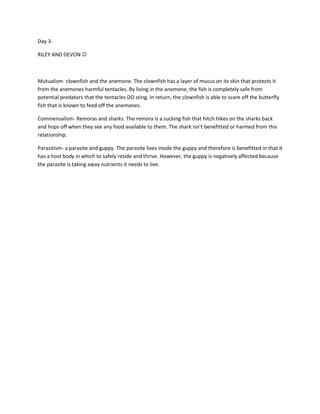Recommended
Recommended
More Related Content
What's hot
What's hot (6)
Similar to Day 3
Similar to Day 3 (20)
Describe three different symbiotic relationships, with examples. Whi.pdf

Describe three different symbiotic relationships, with examples. Whi.pdf
31. Relationships I, II, and III, are called, respectively, Symbiot.pdf

31. Relationships I, II, and III, are called, respectively, Symbiot.pdf
Day 3
- 1. Day 3-<br />RILEY AND DEVON <br />Mutualism- clownfish and the anemone. The clownfish has a layer of mucus on its skin that protects it from the anemones harmful tentacles. By living in the anemone, the fish is completely safe from potential predators that the tentacles DO sting. In return, the clownfish is able to scare off the butterfly fish that is known to feed off the anemones. <br />Commensalism- Remoras and sharks. The remora is a sucking fish that hitch hikes on the sharks back and hops off when they see any food available to them. The shark isn’t benefitted or harmed from this relationship. <br />Parasitism- a parasite and guppy. The parasite lives inside the guppy and therefore is benefitted in that it has a host body in which to safely reside and thrive. However, the guppy is negatively affected because the parasite is taking away nutrients it needs to live. <br />
